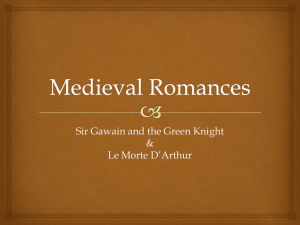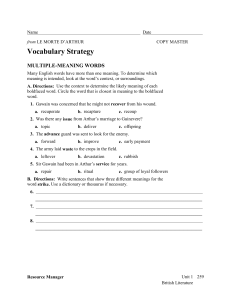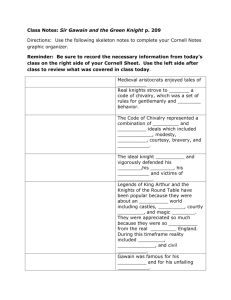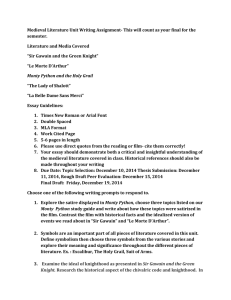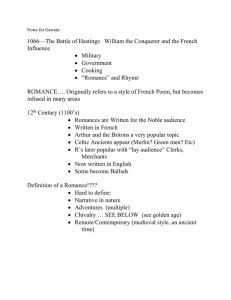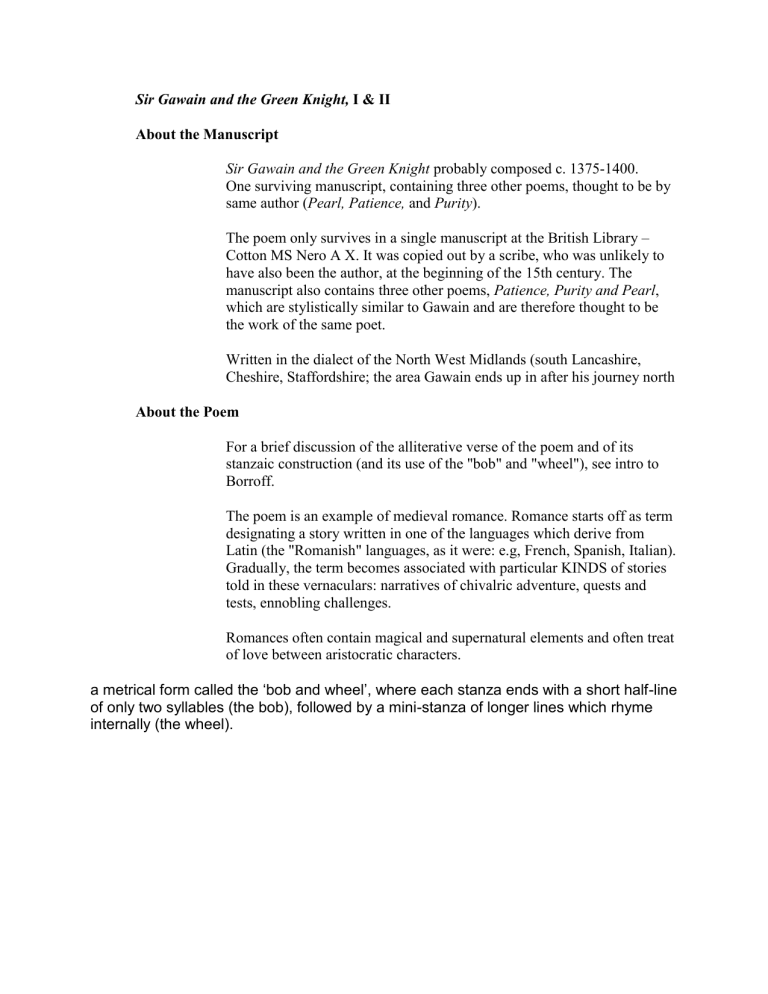
Sir Gawain and the Green Knight, I & II About the Manuscript Sir Gawain and the Green Knight probably composed c. 1375-1400. One surviving manuscript, containing three other poems, thought to be by same author (Pearl, Patience, and Purity). The poem only survives in a single manuscript at the British Library – Cotton MS Nero A X. It was copied out by a scribe, who was unlikely to have also been the author, at the beginning of the 15th century. The manuscript also contains three other poems, Patience, Purity and Pearl, which are stylistically similar to Gawain and are therefore thought to be the work of the same poet. Written in the dialect of the North West Midlands (south Lancashire, Cheshire, Staffordshire; the area Gawain ends up in after his journey north About the Poem For a brief discussion of the alliterative verse of the poem and of its stanzaic construction (and its use of the "bob" and "wheel"), see intro to Borroff. The poem is an example of medieval romance. Romance starts off as term designating a story written in one of the languages which derive from Latin (the "Romanish" languages, as it were: e.g, French, Spanish, Italian). Gradually, the term becomes associated with particular KINDS of stories told in these vernaculars: narratives of chivalric adventure, quests and tests, ennobling challenges. Romances often contain magical and supernatural elements and often treat of love between aristocratic characters. a metrical form called the ‘bob and wheel’, where each stanza ends with a short half-line of only two syllables (the bob), followed by a mini-stanza of longer lines which rhyme internally (the wheel). "Exfoliating" Sign Systems This poem is full of complex sign systems, ambiguous texts, which constantly invite our interpretation. Consider the ambiguous nature of the Green Knight: the multiplying mixed signals his description offers (e.g., the holly bush and the ax in his hands: green branch of peace, weapon of war). The challenge: the "Christmas game," which also involves a legal contract and a test of Gawain's "trouthe," a Middle English word whose connotations encompass truth, pledged word, faithfulness between lovers, personal integrity. See Kane’s essay "The Liberating Truth" (in Chaucer and Langland). The arming of Gawain as knight of the pentangle: resonance (both secular and spiritual) of the pentangle as sign of Gawain The "endless knot": The five defining virtues associated with Gawain (see Borroff and Longman intros). Gawain's Journey North Consider the significance of what the poet does and does not choose to expand upon in narrating the journey. In particular look at Christian references. The northern court: structural doubling of Green Knight's arrival at Camelot in the arrival of Gawain, the stranger, at the mysterious castle. The business of naming (the resonance of the surrendered identity). The northern courtiers' reconstruction of Gawain's identity, their emphasis on his command of the courtly arts and of "love-talking." The new game: Gawain's trouthe on the line again in the "exchange of winnings" contract. Sir Gawain and the Green Knight, III & IV Sir Gawain and its Audience Note the poet's manipulation of readerly expectations and of the conventions of romance. What is the real quest, what is the real test in this poem? What interpretative challenges are posed when the readers know more than the protagonist apparently does? The Element of the Erotic Courtly love, or fin amor: the emphasis on graceful and idealized relations between the sexes. Note: Courtly love is an almost entirely literary phenomenon. The northern court's emphasis (and the lady's particular emphasis) on Gawain's reputation for graceful dalliance and "love-talking." Gawain, not Lancelot, as representative of idealizing love that supposedly moves the lover to improved moral status Narrative Interlace The poem's sophisticated narrative design: the significant interlacing of the three outdoor hunts and the skirmishes in the bedroom. "Courtesye" vs. "Clannes" in the verbal battles in the bedroom: Gawain's dilemma being that his trouthe is on the line in the exchange-of-winnings game. The redefinition of the green girdle from love token to magical talisman. Roles played by Christian ceremonial (prayers, blessings, Mass, confession) What precisely is the nature of Gawain's mistake or failing in accepting the girdle? The meeting in the Green Chapel: once it is revealed that Gawain's host and the Green Knight are the same person, the need for retrospective reinterpretation of Gawain's experience. Entanglement of the outcome of the "beheading" game with the outcome of the "exchange-of-winnings" game, which itself was all bound up with how Gawain responded to the temptation of the hostess. The Moral of the Story? Status of Green Knight at end of poem: Spiritual guide? Father confessor? Force of nature? Agent of mysterious supernatural forces? To what extent is he a free agent? Antifeminist rants, roles played (in retrospect) by Guinevere, Bercilak’s wife, Morgan le Fay? Multiplication of testers; of tests, games and contracts; of temptations; and multiplying judgments upon Gawain's performance. How do we reconcile the Green Knight's judgment of Gawain, Gawain's self-judgment, and the Round Table's assessment of his success? (Note that the poet doesn't explicitly tell us which to prioritize.) The constant renegotiation of the significance of the green girdle in the later stages of the poem: its metamorphosis into a WWGD lace. Redefinition of Gawain's identity? The knight defined by the endless knot of the pentangle becomes the knight who is marked by the green girdle. The poet's refusal to offer us any encompassing moral; the reader must make the final call on the particular significance of Gawain's questing and testing. Cp. and contrast with Pearl: same poet, more complex poetic technique, more sophisticated moral stances, less explicitly clear theological positions. Advance on genre—philosophical and ethical romance—real advance over Marie and French precursors. ClassicNotes on Sir Gawain and the Green Knight Main Themes Nature vs. Human Society: This is the central conflict which Gawain must deal with in his quest. He is forced to confront the forces of Nature both external and internal -- in the form of the Green Knight, the winter landscape, his own sexual desire, and ultimately, his own fear of death. Throughout, Gawain counters this with his own faith in God and in chivalric values. But in the end his natural fear of death overcomes his sense of human morality, causing him to accept the green girdle. And when Gawain returns to human society at the end of the poem, it is with a sense of unease, having realized the power of Nature in comparison to his human beliefs. Throughout the poem, we see natural settings and impulses constantly opposed to those of human society and civility. And while humans shy away from their inevitable death, it is Nature which can continue to restore and regenerate itself, as seen in the indestructible Green Knight and the passing and resurrection of the year. The Futility of Human Constructions: The poem is full of detailed descriptions of human constructs, like armor, clothing, food, architecture, even the cutting of hunted deer. There is a ritualistic, overly technical sense to these descriptions, where the poet seems to be hinting at the superficiality of these human constructs and questioning their purpose. For example, the concept of Courtly Love is one such elaborate human construction, but in Fitt III, it is essentially parodied in the conversations between Gawain and Lady Bertilak. And Gawain's sumptuous armor, no matter how well-forged or polished, will be of little use to him when he receives the exchange stroke from the Green Knight. In comparison to the powerful descriptions of natural forces, these human constructions appear silly, excessive, and ultimately futile. The Viability of Chivalric Values: Perhaps the most significant of these human constructions is chivalric code which forms such an essential part of medieval literature and of Gawain's belief system. Gawain is the very embodiment of chivalric values, yet his encounter with the seductive Lady Bertilak forces a crisis in the chivalric value system: should he honor the requests of the noble lady or remain faithful to his lord? Upon his return to Camelot, King Arthur does not even detect the moral crisis within Gawain. And most unexpectedly, the "test" of Gawain's chivalric values have been in fact a game engineered by Morgan le Fay for a less-than-noble purpose. Disillusioned, the once-idealistic Gawain finds that the code of chivalry which once formed his moral core has now been shaken. Faith in God: In contrast to the questionable nature of the chivalric code, the poet upholds Christian faith as the ultimate, saving grace for humanity. Ever pious, Gawain continuously finds guidance in God: from the image of the Virgin Mary on the inside of his shield to his prayers while journeying alone, to his narrow escape from the adulterous temptations of Lady Bertilak. It is, in a sense, faith in God which enables mankind to negotiate between the dangers of human society and the dangers of the natural world. To affirm this, the poem concludes with a supplication to Jesus Christ, the Savior. Celtic Pagan Sources and Christian overlay: Despite its Christian message, the poem has strong roots in Celtic pagan myth. There are many elements common to pre-Christian Celtic mythology, such as the waiting period of twelve months and a day, the Beheading Game, and the Temptation Game. The Green Knight himself is a strongly pagan character, similar to the Green Man or Wild Man of the Woods who symbolizes fertility in folklore. Gawain's journey can even be seen as the hero's archetypical encounter with the Otherworld, an essential theme in pagan belief. The Pentangle is often a pagan symbol; thus Gawain' s shield, with the Pentangle on one side and the Virgin Mary on the other, comes to represent the dual pagan/Christian nature of the poem. Typical of the Arthurian tradition: the seemingly comfortable co-existence of Christian and pagan in the tradition. Questioning the Romance: The poem contains many conventions of the medieval romance tradition, but in many ways it does not celebrate the genre. Many elements verge on parody; others seem deliberately excessive. The conversation between the seductive Lady Bertilak and the diplomatic Gawain satirizes the language of Courtly Love, the descriptions of armor and clothing can be over-the-top, and the poem does not conclude with the resolution of the typical romance. Instead, there is a sense of unease, as the poet concludes what seems to be a subtle questioning of the romance genre. The Fall of Man and Loss of Innocence: Biblical parallels can be found in the appearance of Bertilak's castle (Paradise) and the role of his wife as temptress (Eve). Accordingly, Gawain loses his moral innocence when his value system is shattered by the end of the poem. Such an allegory emphasizes once more the poet's Christian message, and the relationship between mankind and the divine. Fitt I Analysis The conventions of the romance genre: Gawain appears to fit neatly into the genre of the medieval romance, a French poetic form which had great influence in England beginning in the middle of the twelfth century. The romance has several characteristics: a celebration of warrior society, a setting amidst the feudal nobility, close attention to details of pageantry, and most importantly an emphasis on the chivalric concept of courtly love. This last idea hinged on the relationship between the ideal hero the knight errant and the noble woman he loves. However, in the aristocratic society of chivalry, the most supreme kind of courtly love was for an unattainable woman, often the queen of a knight's lord. A knight's love for this lady would inspire him to braver deeds, just as, in the traditional Arthurian material, Sir Lancelot was driven to great accomplishments by his love for Queen Guinevere Thus, in a larger sense, the code of chivalry focused on the protection of the weak and fair elements of society by the loyal, selfsacrificing knight. But it also included a knight's fidelity to his court and king, and his respect for other warriors and the rules of combat. It is important to consider Gawain in light of the conventions of the romance genre. All the characteristics of the romance are present, however, closer examination suggests a questioning of the values of chivalry and the typical romance. Does the poet really support these values, even when he writes in the style of the romance? Is there a not a greater irony to his description of conventional romance elements, or to the way the events unfold in the poem? Remember the poem was written sometime in the fourteenth century, at a time when the romance genre was already a dying form. Thus, the poet, while not exactly satirizing the romance, could certainly be expressing his doubts about the values and social institution of the chivalric court by playing within the bounds of the romance genre. Fitt I and the Romance Genre: From the very beginning, Fitt I corresponds with expected conventions of the romance genre. Among these is the opening exposition which establishes the historical setting via a list of previous battles and legendary heroes. Many other romances and epics (another popular genre of the time) began this way, establishing a link with the legendary past and thereby legitimizing the unfolding content of the current narrative. When the poet focuses upon Arthur's court, this too is a romantic convention, for Arthur and his knights were already a popular topic of romances, serving as the ideal of chivalric loyalty and valor. Again, it is no surprise that the scene unfolds at a great New Year's feast, another romantic convention, for this provides the poet with a chance to display the chivalric society at its greatest and most vibrant. Notice how he describes Arthur and his knights in superlatives, as the most famous knights in Christendom and the handsomest of kings. Superlative mention is also made of Queen Guinevere, her beauty and nobility, with particular attention paid to the details of her dress and accoutrements. Finally, the poet emphasizes Arthur's wish for a great wonder or tale to entertain him at the feast, again an affirmation of the typical view of Camelot as a place of adventure and unparalleled bravery. In all these elements the historical opening, the Arthurian setting, the opulent feast, the superlative portrayal of Guinevere, the lavish attention to detail, and Arthur's desire for adventure in all of these, the poet acts clearly within the convention of the romance. But perhaps it is not so simple, for as we have noted earlier, the poet seems to be questioning the values of the chivalric romance at the same time he uses the conventions. The historical opening hints at the darker side of British history, writing that war, misery and distress, have alternated with prosperity since the founding of Britain. Already, this is no glorifying portrayal of military values. Also, the superlative description of Camelot verges on the excessive. A poet this skilled in description would surely be able to exalt Arthur and his court in a less simplistic manner. But lines 36-40 are so unsophisticated in their utmost praise of Camelot that we cannot help but question the poet's genuine belief in its glory. Certainly this supposed "greatness" of Camelot is something we will want to consider at the end of the poem, when Gawain has returned to Arthur after his momentous adventure. In similar ways, the poet's description of the lavishness and merriment at the New Year's feast suggests a certain decadence in Arthur's court. The description of Guinevere thus far is in keeping with romantic conventions of the exalted noble woman, but these portrayals of women will continue to evolve throughout the poem, calling into question the concept of courtly love. Meanwhile, in Line 86 the poet describes Arthur as restless, youthfully light-hearted and rather boyish ("so joly of his joyfnes, and sumquat childgered"). While this is certainly a young, attractive King Arthur, in the springtime of life, we get the sense that this Arthur is also somewhat immature, demanding great wonders as an entertainment before his feast, and not as events with serious outcomes and implications. Again, we should consider this at the end of the poem, when Arthur and the court react to the result of Gawain's quest. For the meantime, Fitt I continues with more subtly ambiguous treatment of romantic conventions. Considerable detail is lavished on the stranger's physical appearance, down to the ornamental knots in the mane of his horse. When the stranger speaks, his half-mocking tone provides another chance to criticize the chivalric court. And surely, the initial silence of the court affirms his censure of Camelot's cowardice, despite its reputation of valor. Arthur responds nobly to the challenge, but the poet describes the wary king in not-so-flattering terms, at least in comparison to the magnificent and towering stranger. Gawain's speech, while deferential and self-effacing, is perhaps too deferential, perhaps hiding a criticism of the other cowardly court members as he begrudgingly accepts the challenge for his king? The repeated terms of agreement between the Green Knight and Gawain serve to reinforce the chivalric code of respect for the rules of combat. Yet for all their seriousness, Arthur at the end of the fitt lightly ignores the implications of Gawain's mission, urging for more revelry and suggesting again, the immature and decadent Camelot of this complicated romance. As the poem progresses and Gawain moves from Camelot to other settings, it will be important to view other romantic conventions as they appear and consider their commentary on the values of chivalry. Links with Celtic mythology: Another way to view Gawain is to consider its relationship with Celtic mythology, something frequently present in Arthurian material. The Celts, the people who lived in the British Isles prior to the arrival of the Romans and the Anglo-Saxons, had a strong body of pagan belief, ritual practices, and stories surrounding those beliefs and practices. Many of the characters in these myths were gods and goddesses; many of their ritual practices and beliefs echoed motifs in their myths. As the Middle Ages progressed and Christianity grew more dominant, these motifs and characters were often preserved in the folklore and literature of the British Isles. Arthurian material is particularly notable for its ties to Celtic myth, for many of the characters and events in these stories resemble gods and motifs in the older myths. In Gawain, there is a constant sense of the Celtic, pagan cosmology underlying the events with the Green Knight and Gawain's quest. As the poem progresses, this becomes especially complicated when set against the obvious Christianity in the story: Christian belief and pagan ritual mingle in intricate ways in Gawain. Fitt I and Celtic mythology: In Fitt I, this link with Celtic belief is most noticeable in two ways: in the Christmas/New Years setting of the scene and in the figure of the Green Knight. Celtic pagan belief considered the year to be an important cycle in both the human and natural worlds. The Celts designated a certain time of year as the end of the old year and the beginning of the new one. At this "limbo" time of year, strange, supernatural events were likely to happen and the human world was likely to come in contact with the Otherworld of mystical beings. At the same time, though, the year was made new and revelry often took place to celebrate the new year and release the excess of spiritual energy. Traditionally, this designated time of year took place around November 1 for the Celts, and was known as Samhain. However, with the influence of Christianity and more Continental beliefs, this limbo time was moved to the period between Christmas and New Year's day. Gawain corresponds with this pattern, with the strange Green Knight bursting in upon King Arthur's court on New Year's day. In this way, he can be seen as an Otherworldly visitor to the human world, as a strange, unaccountable force of nature entering Camelot, the epitome of civilized society. The bizarre beheading game has been seen to represent the ritual slaying and renewal of the year. There are in fact direct parallels between the beheading game in Gawain and an eighth-century Irish myth, "Bricriu's Feast." In this tale, the Celtic hero Cuchulainn must behead an Otherworldly figure at a feast, with similar consequences the apparent immortality of the other figure and the challenge for an exchange stroke a year later. In both cases, the Beheading Game has a ritual, pagan significance, suggesting the regenerative quality of Nature and the turning of the year. In Gawain, the Green Knight in fact designates the following New Year's day as the date for the exchange blow, thus emphasizing the significance of the year as a cycle of time. And renewal and regeneration are certainly implicit in the Green Knight's immortality, since the beheading has no effect on him. Another clue to his Otherworldly nature would be his green color. Green, as the dominant color in nature, here suggests the natural cycle of rebirth and renewal that is so essential to the concept of the year and, as well, to the character of the Green Knight. Symbols in Fitt I: The Green Knight himself thus serves as an important symbol in the story. We have already established that he personifies the renewable, indestructible forces of nature, entering human society on New Year's Day. But his description merits a closer look, for the poet does not portray him solely as a figure of terror and foreignness. In fact, the Green Knight is a mixture of the familiar (the civil) and the foreign (the raw). He is opulently dressed and clearly noble, yet his green color and sheer size indicate he is not entirely of this world. Thus, the Green Knight functions as a liminal figure, mediating between the civilized world of chivalry and the unknown world of nature. As we will see later on, he not only signifies the ritual renewal of the natural cycle, but also calls into question the civilized structure of chivalric and Christian values which confront Gawain. Several specific traits of the Green Knight should be noted in this light. First, he bears in one of his hands a branch of holly and in another a cruel battle-axe. This clearly symbolizes his dual function. On one level it indicates his civilized wish for peace, offset by his potential for destruction. On another level, it symbolizes his understanding of the rules of society, despite his innate link with the natural world. We should also note the recurring colors of green and gold in the description of the Green Knight. Similar to the battle-axe and holly, the green obviously indicates his raw, natural character, yet the gold implies something different. Gold is, after all, often associated with wealth, royalty, and the ultimate level of society. In medieval times, it was seen as the desired end product of the meticulous process of alchemy, the final possible attainment for human beings. Thus, the gold here brings a note of civility and social greatness to the figure of the Green Knight, in addition to his Otherworldly nature. As the poem progresses, green and gold will continue to take on a greater significance, especially in relation to the character of Gawain himself.
